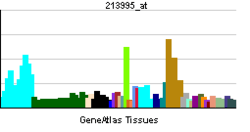ATP5S
ATP synthase subunit s, mitochondrial is an enzyme that in humans is encoded by the ATP5S gene.[3][4][5]
This gene encodes a subunit of mitochondrial ATP synthase. Mitochondrial ATP synthase catalyzes ATP synthesis, utilizing an electrochemical gradient of protons across the inner membrane during oxidative phosphorylation. ATP synthase is composed of two linked multi-subunit complexes: the soluble catalytic core, F1, and the membrane-spanning component, Fo, comprising the proton channel. This gene encodes the subunit s, also known as factor B, of the proton channel. This subunit is necessary for the energy transduction activity of the ATP synthase complexes. Alternatively spliced transcript variants encoding different isoforms have been identified.[5]
References
Further reading
- Kinosita K, Yasuda R, Noji H (2003). "F1-ATPase: a highly efficient rotary ATP machine". Essays Biochem. 35: 3–18. PMID 12471886.
- Oster G, Wang H (2003). "Rotary protein motors". Trends Cell Biol. 13 (3): 114–21. doi:10.1016/S0962-8924(03)00004-7. PMID 12628343.
- Leyva JA, Bianchet MA, Amzel LM (2003). "Understanding ATP synthesis: structure and mechanism of the F1-ATPase (Review)". Mol. Membr. Biol. 20 (1): 27–33. doi:10.1080/0968768031000066532. PMID 12745923.
- Sanadi DR, Pringle M, Kantham L, et al. (1984). "Evidence for the involvement of coupling factor B in the H+ channel of the mitochondrial H+-ATPase". Proc. Natl. Acad. Sci. U.S.A. 81 (5): 1371–4. doi:10.1073/pnas.81.5.1371. PMC 344835
 . PMID 6143319.
. PMID 6143319.
- Yu W, Andersson B, Worley KC, et al. (1997). "Large-Scale Concatenation cDNA Sequencing". Genome Res. 7 (4): 353–8. doi:10.1101/gr.7.4.353. PMC 139146
 . PMID 9110174.
. PMID 9110174.
- Elston T, Wang H, Oster G (1998). "Energy transduction in ATP synthase". Nature. 391 (6666): 510–3. doi:10.1038/35185. PMID 9461222.
- Wang H, Oster G (1998). "Energy transduction in the F1 motor of ATP synthase". Nature. 396 (6708): 279–82. doi:10.1038/24409. PMID 9834036.
- Strausberg RL, Feingold EA, Grouse LH, et al. (2003). "Generation and initial analysis of more than 15,000 full-length human and mouse cDNA sequences". Proc. Natl. Acad. Sci. U.S.A. 99 (26): 16899–903. doi:10.1073/pnas.242603899. PMC 139241
 . PMID 12477932.
. PMID 12477932.
- Cross RL (2004). "Molecular motors: turning the ATP motor". Nature. 427 (6973): 407–8. doi:10.1038/427407b. PMID 14749816.
- Ma J, Dempsey AA, Stamatiou D, et al. (2007). "Identifying leukocyte gene expression patterns associated with plasma lipid levels in human subjects". Atherosclerosis. 191 (1): 63–72. doi:10.1016/j.atherosclerosis.2006.05.032. PMID 16806233.

 . PMID 6143319.
. PMID 6143319. . PMID 9110174.
. PMID 9110174. . PMID 12477932.
. PMID 12477932.